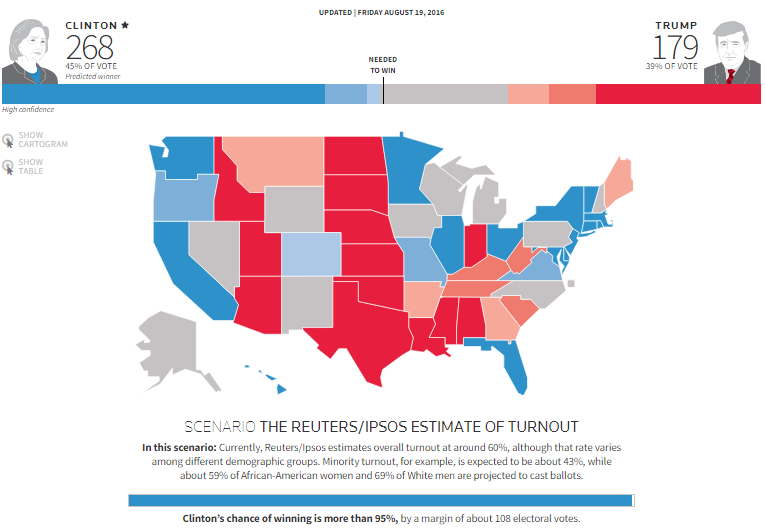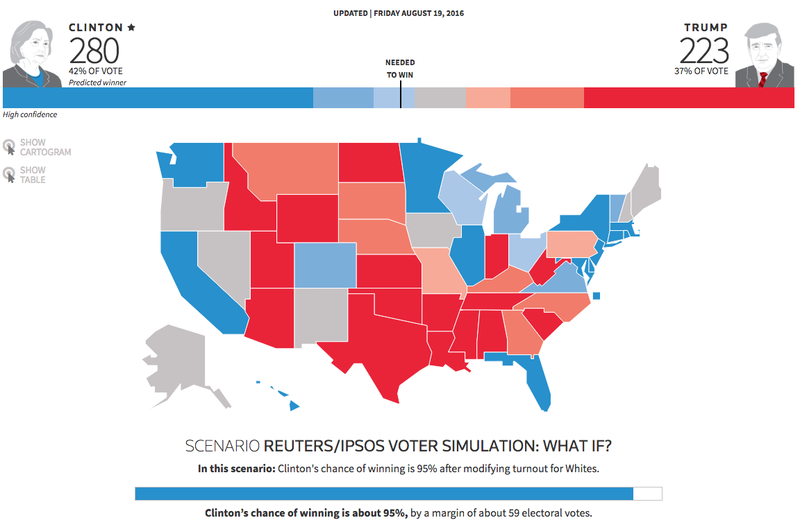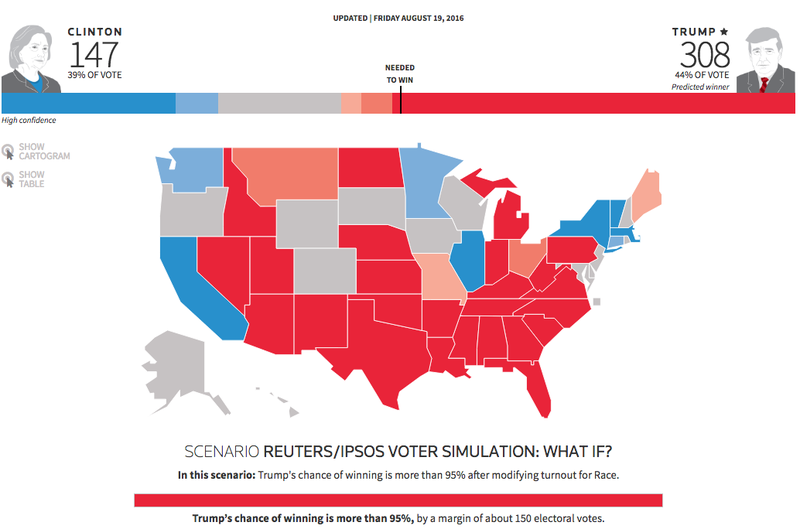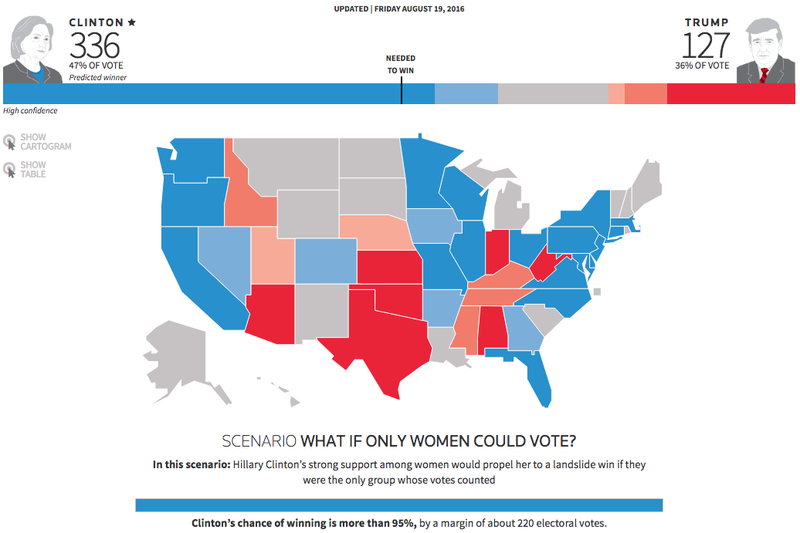Sign up for the daily CJR newsletter.
Campaign season is a quadrennial reminder that numbers often drive the most consequential stories. Census surveys are sliced and diced into shareable charts. A glut of polling is chewed up and spit out as intricate graphics. Election forecasters roll out bigger, better, and more interactive models. Altogether, it’s something of a data visualization arms race.
The latest entrant is Reuters*, which on Wednesday unveiled an election simulation tool powered by an Ipsos national tracking poll whose sample size has been vastly expanded to about 15,000 to 17,000 a week. “States of the Nation” estimates the probability of different electoral college results based on varying turnout scenarios. In a function particularly useful to journalists attempting to contextualize the campaign, it also allows users to create their own outcomes by adjusting turnout among specific segments of the population.
“In my view, it’s not difficult to predict what the general population feels about a particular subject on any given day—the issue on Election Day is who the hell shows up to vote,” says Mo Tamman, Reuters’s editor in charge of data and computational journalism. “We can’t predict snowstorms in Ohio or electrical outages in New York. There’s any number of reasons that turnout is high or low in any given state in any given year. This allows us as journalists—and also anyone else who wants to go to the site—to gauge those probabilities and the impact they may have.”
August 24 Reuters/Ipsos forecast at its estimated level of turnout, 60 percent nationwide.
If the only people voting this year were white men who make more than $100,000, for example, Reuters projects Hillary Clinton would still have a high likelihood of carrying New York, California, and Illinois. Such snapshots come in an election year in which major political fault lines correspond to demographic divisions. Donald Trump’s support is narrow, but deep. Reuters’s gadget helps estimate just how much of his mostly white coalition must turn out to sway electoral outcomes in individual states.
This has been a central topic of discussion since the GOP defeat in 2012. Conventional wisdom among journalists and mainstream Republicans alike holds that the party’s future electoral success depends on broadening its support among growing minority groups. But in one of the seminal analyses dissecting this idea, Real Clear Politics analyst Sean Trende argued in 2013 that the more important demographic shift between 2008 and 2012 was a drop in white voters. Improving turnout among these “largely downscale, Northern, rural whites,” Trende wrote, could soften the impact of other demographic shifts on the GOP.
This is essentially the premise of Trump’s campaign strategy, if it can be called that—forcing journalists to analyze communities they don’t typically cover very well. The shrinking of local news organizations and general retreat from bureaus by national players has no doubt accentuated this difficulty.
August 24 Reuters/Ipsos forecast with 100 percent turnout among white voters.
Still, increasingly sophisticated data operations at various outlets have helped fill at least some of that void by analyzing big-picture shifts in demographics and public opinion. There are limits to such efforts—the best polling analyses include clear caveats and methodologies—but they have produced useful illustrations of the aggregate story nationwide.
During primary season, Real Clear Politics and FiveThirtyEight built interactives that gave users the power to adjust party preference and turnout among subgroups from their 2012 levels. NPR made a similar tool, The 270 Project, once the general election matchup of Trump and Clinton was set.
“We at NPR Politics wanted a data-driven, quantitative way to answer the fundamental question of whether Trump can win, or if this is Hillary Clinton’s race to lose—and [to] give readers the power to test it out themselves,” NPR political reporter Asma Khalid wrote while introducing the tool to readers. “There’s perhaps no better way to do that than through demographics.” Factors like race and socioeconomic status are arguably among the best predictors of how we’ll vote.
Such demographic-focused interactives come in addition to forecast models–including those at FiveThirtyEight, The New York Times, and elsewhere––which aggregate and weight polls and other information to predict candidates’ probabilities of winning. Last week, Vox added another model to the mix, though its premise was a tad more creative: tracking the “Trump Tax,” defined as “the electoral penalty Republicans appear to be paying for nominating Trump.”
With “States of the Nation,” Reuters is combining the timeliness of current polling data, as seen in the big-name forecasting models, with the interactive analysis of turnout among subgroups, as seen in some of the more retrospective simulators, such as NPR’s.
August 24 Reuters/Ipsos forecast if only white people were allowed to vote.
“As a journalist, we present [poll] numbers as if they’re set in stone: Among likely voters, this is what it is,” Tamman says. “And this allows us in our coverage to say, for example, not just that Hillary is ahead by four points, but a much more sophisticated statement: If, as anticipated, turnout is relatively moderate, Hillary has a significant advantage in the electoral college. If it turns out to be a high-turnout or low-turnout election, her advantage in the electoral college is minimized significantly.”
Reuters’s simulator depends on the accuracy of Ipsos’s weekly tracking poll. It is unwise to rely on any single survey to analyze the state of the race—polling averages provide a more comprehensive picture—but the new tool does help capture the historical arc of demographic change. FiveThirtyEight gave Ipsos an “A-” in its most recent rating of pollsters—strong by the news organization’s standards. What’s more, the firm also expanded its weekly sample size about sixfold to allow Reuters users to cut up respondents’ demographic data by sex, race and ethnicity, income range, age, and party affiliation.
“At 15,000, [the sample size] gives us basically state-level data for all the key battleground states,” says Reg Chua, Reuters’s executive editor of editorial operations, data, and innovation. “There are, of course, state-level polls being done, but this gives us a continuously tracking, single-methodology poll all the way through the election. When we start aggregating weeks, it gives us state-level data for pretty much all the states.”
August 24 Reuters/Ipsos forecast if only women were allowed to vote.
When I visited Reuters’s Times Square offices earlier this month to preview the tool, Tamman highlighted built-in turnout scenarios users can select; they can also create their own scenarios. Should turnout among various demographic groups mimic that of the 2000 election, when George W. Bush carried South Carolina by a 16-point margin, the Reuters/Ipsos poll suggests the state could now be in play.
That’s not necessarily a groundbreaking political or demographic analysis. But the ability to put numbers behind it—to cross-reference an estimate of current voter sentiment with potential turnout—is useful both as a social science experiment and a reporting tool. That’s especially true in the age of Trump, when the story is not just analyzing whether his strategy is succeeding, but also if it’ll irrevocably harm the GOP should it fail.
“The functionality here,” Chua says, “in terms of being able to make your own adventure with turnout, is one of the most useful things that we have.”
Tamman cuts in: “Make your own fantasy, too.”
*Reuters Editor in Chief Stephen J. Adler chairs CJR’s board of overseers.
Has America ever needed a media defender more than now? Help us by joining CJR today.











